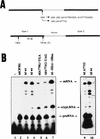A ribosomal function is necessary for efficient splicing of the T4 phage thymidylate synthase intron in vivo
- PMID: 9573049
- PMCID: PMC316773
- DOI: 10.1101/gad.12.9.1327
A ribosomal function is necessary for efficient splicing of the T4 phage thymidylate synthase intron in vivo
Abstract
Splicing of the group I intron of the T4 thymidylate synthase (td) gene was uncoupled from translation by introducing stop codons in the upstream exon. This resulted in severe splicing deficiency in vivo. Overexpression of a UGA suppressor tRNA partially rescued splicing, suggesting that this in vitro self-splicing intron requires translation for splicing in vivo. Inhibition of translation by the antibiotics chloramphenicol and spectinomycin also resulted in splicing deficiency. Ribosomal protein S12, a protein with RNA chaperone activity, and CYT-18, a protein that stabilizes the three-dimensional structure of group I introns, efficiently rescued the stop codon mutants. We identified a region in the upstream exon that interferes with splicing. Point mutations in this region efficiently alleviate the effect of a nonsense codon. We infer from these results that the ribosome acts as an RNA chaperone to facilitate proper folding of the intron.
Figures









Similar articles
-
RNA chaperone StpA loosens interactions of the tertiary structure in the td group I intron in vivo.Genes Dev. 2002 Sep 1;16(17):2300-12. doi: 10.1101/gad.231302. Genes Dev. 2002. PMID: 12208852 Free PMC article.
-
Self-splicing of the bacteriophage T4 group I introns requires efficient translation of the pre-mRNA in vivo and correlates with the growth state of the infected bacterium.J Bacteriol. 2007 Feb;189(3):980-90. doi: 10.1128/JB.01287-06. Epub 2006 Nov 22. J Bacteriol. 2007. PMID: 17122344 Free PMC article.
-
Assaying RNA chaperone activity in vivo using a novel RNA folding trap.EMBO J. 1999 Jul 1;18(13):3776-82. doi: 10.1093/emboj/18.13.3776. EMBO J. 1999. PMID: 10393192 Free PMC article.
-
Folding of the td pre-RNA with the help of the RNA chaperone StpA.Biochem Soc Trans. 2002 Nov;30(Pt 6):1175-80. doi: 10.1042/bst0301175. Biochem Soc Trans. 2002. PMID: 12440999 Review.
-
A unique group of self-splicing introns in bacteriophage T4.Indian J Biochem Biophys. 2001 Oct;38(5):289-93. Indian J Biochem Biophys. 2001. PMID: 11886074 Review.
Cited by
-
Monitoring intermediate folding states of the td group I intron in vivo.EMBO J. 2002 Oct 1;21(19):5281-91. doi: 10.1093/emboj/cdf504. EMBO J. 2002. PMID: 12356744 Free PMC article.
-
Pentamidine inhibits mitochondrial intron splicing and translation in Saccharomyces cerevisiae.RNA. 2000 Jul;6(7):937-51. doi: 10.1017/s1355838200991726. RNA. 2000. PMID: 10917591 Free PMC article.
-
The Role of RNA Secondary Structure in Regulation of Gene Expression in Bacteria.Int J Mol Sci. 2021 Jul 22;22(15):7845. doi: 10.3390/ijms22157845. Int J Mol Sci. 2021. PMID: 34360611 Free PMC article. Review.
-
RNA chaperone StpA loosens interactions of the tertiary structure in the td group I intron in vivo.Genes Dev. 2002 Sep 1;16(17):2300-12. doi: 10.1101/gad.231302. Genes Dev. 2002. PMID: 12208852 Free PMC article.
-
RNA chaperone activity and RNA-binding properties of the E. coli protein StpA.Nucleic Acids Res. 2007;35(4):1257-69. doi: 10.1093/nar/gkl1143. Epub 2007 Jan 31. Nucleic Acids Res. 2007. PMID: 17267410 Free PMC article.
References
-
- Bacher G, Luetcke H, Jungnickel B, Rapoport TA, Dobberstein B. Regulation by the ribosome of the GTPase of the signal-recognition particle during protein targeting. Nature. 1996;381:248–251. - PubMed
-
- Belfort M, Moelleken A, Maley GF, Maley F. Purification and properties of T4 thymidylate synthase produced by the cloned gene in an amplification vector. J Biol Chem. 1983;258:2045–2051. - PubMed
-
- Belfort M, Chandry PS, Pedersen-Lane J. Genetic delineation of functional components of the group I intron in the phage T4 td gene. Cold Spring Harbor Symp Quant Biol. 1987;52:181–192. - PubMed
-
- Belfort M, Ehrenman K, Chandry PS. Genetic and molecular analysis of RNA splicing in Escherichia coli. Methods Enzymol. 1990;181:521–539. - PubMed
-
- Caprara MG, Lehnert V, Lambowitz AM, Westhof E. A tyrosyl-tRNA synthetase recognizes a conserved tRNA-like structural motif in the group I intron catalytic core. Cell. 1996a;87:1135–1145. - PubMed
Publication types
MeSH terms
Substances
LinkOut - more resources
Full Text Sources
Molecular Biology Databases
